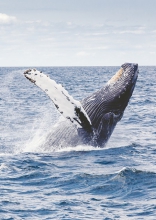Last week, the very last negotiations aimed at adopting an international Convention for the protection of high seas biodiversity took place in New York. The agreement was reached after 17 years of intense discussions and negotiations at the United Nations. Belgium played an active role in drafting and finalising this treaty. Among other things, it will now become possible to create natural areas on the high seas - outside territorial waters.
The new Treaty is of utmost importance for Belgium, as our country, as founder of the Blue Leaders in 2019, is a strong supporter of protecting the ocean and preserving its resources. The adoption of the target of protecting 30% of the ocean by 2030 at the COP Biodiversity in Montreal in December last year was a first important step. The conclusion of this new Convention for the Protection of Biodiversity at Large (BBNJ - Biodiversity Beyond National Jurisdiction, or 'Treaty of the High Seas') is the second and final step before effective protection can be achieved.
The importance of the ocean
The ocean is crucial for sustaining life on Earth. It is the source of food and energy for millions of people, regulates the climate and provides oxygen. Unfortunately, the ocean is threatened by pollution, over-fishing, climate change and other human activities. Protecting our ocean is therefore essential for the future of the planet. One of the main reasons is the unique role the ocean plays in the fight against climate change. For instance, it absorbs about a third of the CO2 emitted into the atmosphere by human activities. This helps to reduce global warming and stabilise the climate.
The importance of nature reserves on the high seas
The new BBNJ treaty was supposed to create natural areas on the high seas. Something that until now could not be done on the high seas. 70% of the earth's surface consists of water of which 3/4 is high seas that could not be fully protected by the international community in any way at present. Thanks to this convention, the second and final step has been taken to transform 30% of that high seas into high seas nature reserves by 2030. Nature reserves on the high seas are areas where human activities are very strictly regulated: sustainable shipping, scientific research with respect for nature, sustainable water tourism, no unbridled fishing. Scientists agree that we need to protect at least 30% with the establishment of natural areas on the high seas to have a resilient ocean that has an impact on climate change. With 30%, you reach the tipping point to keep the other 70% habitable as well. Besides high seas natural areas, the treaty also talks about access to marine genetic resources and the fair sharing of benefits derived from them, environmental impact assessments of high seas activities, capacity building and marine technology transfer. Like the climate treaty, the treaty will also organise a Conference of the Parties (COP).
(c) image - Shutterstock
